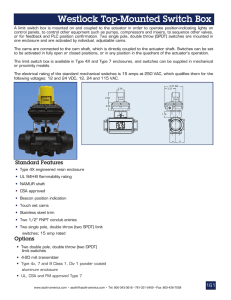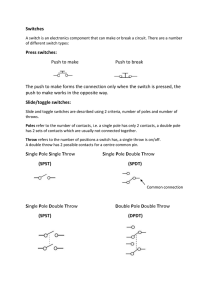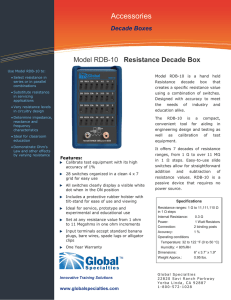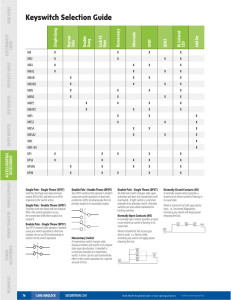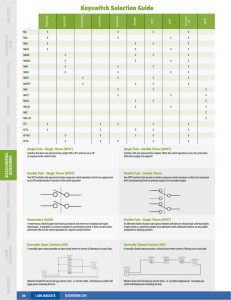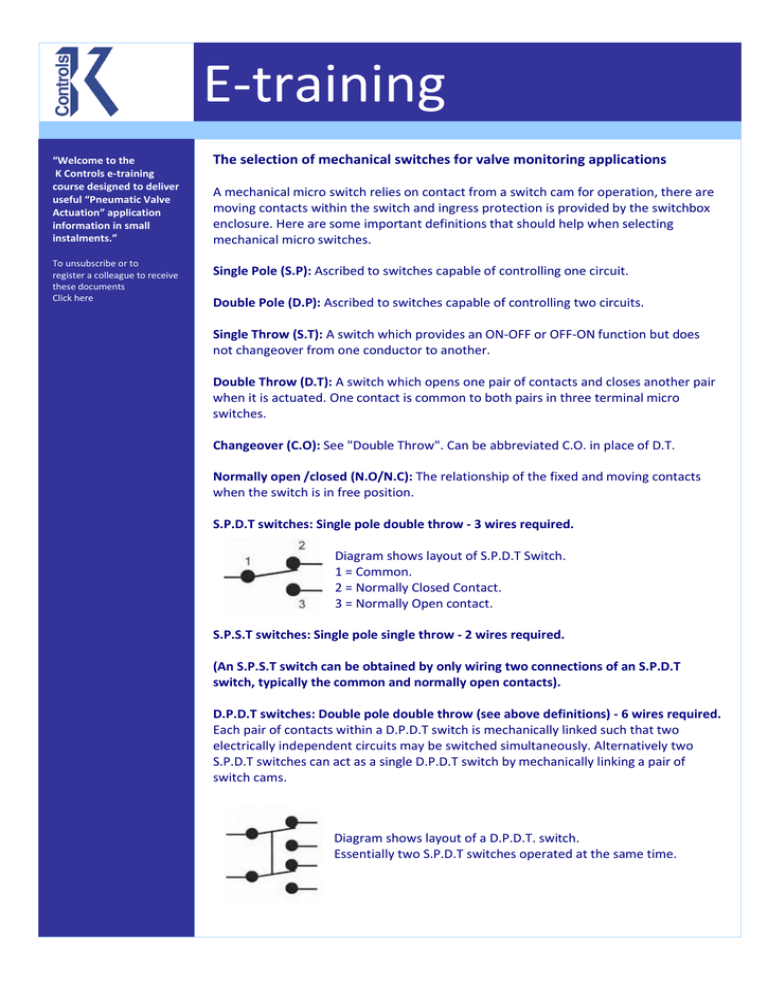
E-training
“Welcome to the
K Controls e-training
course designed to deliver
useful “Pneumatic Valve
Actuation” application
information in small
instalments.”
To unsubscribe or to
register a colleague to receive
these documents
Click here
The selection of mechanical switches for valve monitoring applications
A mechanical micro switch relies on contact from a switch cam for operation, there are
moving contacts within the switch and ingress protection is provided by the switchbox
enclosure. Here are some important definitions that should help when selecting
mechanical micro switches.
Single Pole (S.P): Ascribed to switches capable of controlling one circuit.
Double Pole (D.P): Ascribed to switches capable of controlling two circuits.
Single Throw (S.T): A switch which provides an ON-OFF or OFF-ON function but does
not changeover from one conductor to another.
Double Throw (D.T): A switch which opens one pair of contacts and closes another pair
when it is actuated. One contact is common to both pairs in three terminal micro
switches.
Changeover (C.O): See "Double Throw". Can be abbreviated C.O. in place of D.T.
Normally open /closed (N.O/N.C): The relationship of the fixed and moving contacts
when the switch is in free position.
S.P.D.T switches: Single pole double throw - 3 wires required.
Diagram shows layout of S.P.D.T Switch.
1 = Common.
2 = Normally Closed Contact.
3 = Normally Open contact.
S.P.S.T switches: Single pole single throw - 2 wires required.
(An S.P.S.T switch can be obtained by only wiring two connections of an S.P.D.T
switch, typically the common and normally open contacts).
D.P.D.T switches: Double pole double throw (see above definitions) - 6 wires required.
Each pair of contacts within a D.P.D.T switch is mechanically linked such that two
electrically independent circuits may be switched simultaneously. Alternatively two
S.P.D.T switches can act as a single D.P.D.T switch by mechanically linking a pair of
switch cams.
Diagram shows layout of a D.P.D.T. switch.
Essentially two S.P.D.T switches operated at the same time.
E-training
K Controls designs and
manufactures valve
networking monitoring
and control products:
Switchboxes
Control Monitors
Position Transmitters
Corrosion resistant
ATEX certified – gas + dust
High and low temperatures
IP68 for submersion
Low powered solenoids
Remote I/O compatible
AS-interface®
DeviceNetTM
PROFIBUS® PA
FOUNDATION™ FIELDBUS
4-20mA + HART®
Wireless solutions
Linear or rotary adaptation
K Controls can also
supply your positioner
requirements
D.P.S.T switches: Double pole single throw (see above definitions). 4 wires required.
This is achieved by only wiring two connections of each independent circuit.
Gold plated contacts: Used primarily in applications where switched voltage and
current levels are low, e.g. 1mA at 12 volts, and the corrosion of silver contact switches
would create high resistance contact faults (i.e. a switch appears to be open when
closed). Gold contact micro switches are usually specified on intrinsically safe circuits or
on applications where a switch may remain unused for a long time especially in a
corrosive atmosphere.
Switch ratings: These define a switch's ability to make or break at a given current and
voltage. Heating and arcing eventually limit a switch’s ability to function. If it is not
switching then the mechanism is purely I²R (I = current, R=resistance) heating due to
contact resistance and there won't be any arcing with closed contacts. When the switch
is operated, arcing takes place. In addition to the heat, the contacts get pitted (they
actually melt locally) and there can be a build up of carbon (from burning of particles in
the atmosphere). This increases the contact resistance and eventually, if there is too
much heat, the switch will fail. Keeping the voltage and current within the specification
will ensure a long switch life. It is also important to ensure the application uses the over
travel of the switch plunger because this adds to the contact pressure, reducing the
contact resistance and hence the heat generated in the contacts. (K Controls cam design
ensures there is adequate switch plunger over travel).
AC versus DC switch ratings: Micro switches are derated for DC operation. The reason
for this is that the rate of heat dissipation is directly related to the wattage (volts x
current) and type of the load being switched. A DC voltage is constant whereas an AC
voltage passes through 0 volts twice every 20 milli-seconds. For a given voltage the
average power switched is considerably less on AC systems than on DC and therefore
there will be less arcing. For this reason a switch will handle more AC than DC current.
Inductive versus resistive loads: Most applications in valve monitoring involve switching
resistive loads (e.g. PLC input cards). Occasionally an inductive load will be switched e.g.
a solenoid coil. With inductive loads higher voltages than the nominal are induced
during switching which increase the wattage and thus the heating effect. Therefore any
given switch has an inductive rating that is lower than its resistive rating. As mentioned
above, with DC supplies an arc is generated between the contacts during switching
which adds to the heating effect. However with DC operation on a resistive load, the
switch is operating at a constant current and voltage and therefore there is "constant
arcing". With an inductive load, the back emf generated increases the voltage across the
contacts at switch-off which produces even more arcing. This is the reason why DC
inductive ratings are so low.
Pneumatic mechanical micro switches : Although not often used K Controls products
are available with one or two pneumatic switches. Each is of a "two port with vent"
design and has a rating of 3 to 8 bar. The conduit entry is replaced with a manifold in
which there are three 6mm O/D push-in fittings. Where two switches are fitted, the
manifold provides a common inlet and two outlets. Where one switch is fitted the third
port is blanked.
E-training
K Controls designs and
manufactures valve
monitoring and control
products:
Diagram shows the layout of two, two port with vent
pneumatic switches with a common inlet.
Switchboxes
Control Monitors
Position Transmitters
Corrosion resistant
ATEX certified – gas + dust
High and low temperatures
IP68 for submersion
Low powered solenoids
Remote I/O compatible
AS-interface®
DeviceNetTM
PROFIBUS® PA
FOUNDATION™ FIELDBUS
4-20mA + HART®
Wireless solutions
Linear or rotary adaptation
Similar documents covering reed and inductive proximity switches are available on
request.
K Controls can also
supply your positioner
requirements
If you have any questions
or comments, would like a
colleague to receive this
information or you would
like the latest list of
training documents, please
use the contact details
below:
K Controls Ltd
2 Crown Way
Crown Business Centre
Horton Road
West Drayton UB7 8HZ
United Kingdom
Phone:
+44 (0)1895 449601
Fax:
+44 (0)207 990 8111
E-mail:
sales@k-controls.co.uk
Web:
www.k-controls.co.uk
Blog:
www.k-controls.info
Visit us:
View a map
Trademarks K Controls has used all reasonable resources and efforts to indicate and supply information
regarding trademarks used in this document. The absence of a trademark identifier is not a representation
that a particular word or technology is not a trademark. All trademarks are property of their respective
owners. If we have failed to properly show a trademark, please e-mail us and we will attempt to correct it.
The ownership of all trademarks referred to in this document is acknowledged.
Legal Disclaimer This document is written by K Controls for use by its clients. Although we make every
reasonable attempt to verify the accuracy of the technical information and advice provided, we can take no
responsibility for loss or damage resulting from its interpretation or application. K Controls is not in any way
responsible, and has no legal liability, in respect of the contents of any other web site accessed via this
document, nor for information provided via that site. All information accessed via links in this document is
protected by international copyright laws and may not be reproduced in any form without the explicit
written permission of the author. This E-mail and any files transmitted with it are confidential and may be
legally privileged. It is intended solely for clients of K Controls Ltd. Any unauthorized recipient should advise
K Controls immediately of the error.
Copyright K Controls Ltd 2010 - All rights reserved.

